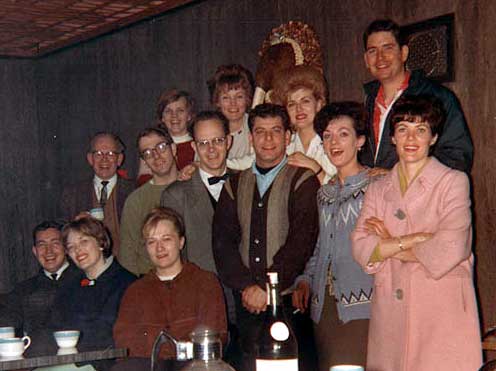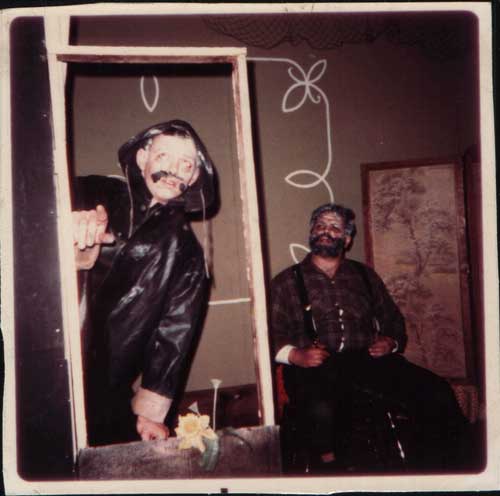 Did you hear that applause? By June Allen March 30, 2004
 A group picture taken at Petersburg when the First City Players took the show on the road in 1966 - Seated in front are (unidentified), Arlene Crawford and (unidentified). In the middle row from left, Tom Kelley (is it?), Bob Allen, Jack Shay, Chuck Maniscalco, Mary Kinerk and Maureen Karlson. Back row from left, (unidentified), June Allen, Margot Shay, and Jim Alguire... Photo courtesy First City Players - Digital by Sitnews....
The first white settlers also carried their own talents and modes of entertainment with them to Ketchikan in the form of a variety of musical instruments from guitars and banjos to fiddles and squeeze-boxes plus their own vocal chords that vibrated in sentimental ballads or salty tall tales. All the saloons - in themselves a form of rowdy good-old-boy entertainment - welcomed their customer-musicians who played for pleasure and applause, or for drinks. And then there were the horn players who, from Ketchikan's earliest days, formed their own very impressive marching brass band that blew rousing melodies for civic and patriotic occasions and softer dirges while stepping softly along the wet plank streets during funeral processions. Within less than a decade of its founding as a city, Ketchikan had gained enough population to make professional stage acts profitable. Before movies and radio, the excitement of vaudeville sated appetites for humankind's oldest art form, theater! In frontier towns across America, refined-sounding "opera houses" were among the first public structures to be built even in the meanest frontier mining camps. In the last frontier of Alaska, Ketchikan called its version of the opera house the Budweiser Vaudeville! It was on lower Front Street, about where the now recently closed Alaska Bar provided its own more modern form of entertainment for its clientele. Promoted by the brewery that sponsored it, the Budweiser Vaudeville house reached for respect and class a cut above its lowly saloon neighbors.  Photo courtesy First City Players - Digital by Sitnews....
While movies remained and still remain popular, the primal urge to act or to share the excitement of watching live actors in performance runs deep. In a 1974 issue of the Southeastern Log, the late Mary Balcom wrote a brief theatrical history of stage events in Ketchikan, gleaned from her memory of the 1920s. She recalled productions by the Ketchikan High School players, plays performed then in the old Red Men Hall on the corner of Main and Dock Streets. She also mentioned the first play performed on the brand new and elaborately framed Main School stage in 1925, co-directed by Emery Tobin - later the founder of the Alaska Sportsman magazine - and Roy Jones - Ketchikan (and Alaska's) first commercial aviation pioneer. Both men were members of Ketchikan's American Legion Post #3, a group dedicated to community involvement. The American Legion, already one of the town's most active community organizations since 1919, produced plays of its own to raise funds for Legion projects. They used the elegant stage facilities of the Coliseum Theater, which opened in 1924. It was built to accommodate not only movies but stage productions as well. But an arson fire on July 15, 1956, reduced the old Coliseum to ashes and the concrete replacement was a sleeker, modern version of a movie house. It left Ketchikan without a performance stage except for the stage in the auditorium of the new west end Ketchikan High School, designed basically for school productions.  Photo courtesy First City Players - Digital by Sitnews....
But it wasn't until 1965 when The First City Players came along that any consideration was given to establishing a permanent theater arts program. And that was not the goal when the First City Players organized but came later by happenstance - in the Congress of the United States. When the Players first organized at a meeting in the undercroft of St. John's Church, it was with the simple goal to "put on a show." The dozen or so founding players were headed by an experienced actor and director, the late Chuck Maniscalco and by Jack Shay, director-to-be, as well as by Jim Alguire, musical director-to-be. It was decided to produce three one-act plays: two short plays Chekov's The Bear and Tennessee Williams' The Long Stay Cut Short, and A.A. Milne's longer one-act about a medieval kingdom, The Ugly Duckling. Additional actors were quickly recruited to fill all the roles. Those initial First City Player "pioneers" of the stage faced a few daunting obstacles. They had no budget because they had no money except in their own pockets. They had no rehearsal space. They had no stage on which to perform. But no problem! They chipped in to order scripts from Samuel French Co. Costumes for the one-acts were cobbled together from whatever could be found. Some of the male performers in the cast of the Ugly Duckling complained bitterly about having to wear tights topped by short, homemade jerkins a la the 16th century or so. Props were collected wherever, however. That leads to the Story of the Rosebush, which epitomizes the community help given the fledgling group of First City Player actors and underscores the fact that the community has wholeheartedly continued to support the theater arts over the years!  Photo courtesy First City Players - Digital by Sitnews....
But the problem during rehearsals was - where in Ketchikan to find a rose bush! Amazingly, Tongass Trading Co. had just such a potted three-foot-high plastic rosebush in stock and generously "loaned " it to the group. Somehow that rose bush wasn't returned to the store right away because it would work so well in the following production of Picnic, which takes places in a front yard. And then it was also exactly right for the very next production of Look Homeward Angel which takes place on a front porch! Then along came the Fish Pirate's Daughter and lo and behold, the rose bush was perfect for the melodrama's opening, expository scene. Today, no one knows or admits knowing whatever happened to that rose bush! It was never returned to Tongass Trading, the company's management never mentioned it, and it is still on the consciences of several of those early players! But the "rose bush" symbolizes the remarkable support given by the business community, by individual merchants, the Chamber of Commerce, the school district, and countless individual supporters of the early First City Player efforts. The melodrama The Fish Pirate's Daughter was first pitched to the Chamber of Commerce as a "tourist attraction" before the play was even written and before tourism had become the commodity it is today. But the town liked the idea! By the time the First City Player's Fish Pirate's Daughter got under way, Gordon Zerbetz of the Stedman Hotel remodeled the hotel's banquet and meeting room to include a small stage for the popular play! The Players still supported themselves via ticket sales and whatever else could be found.  Photo courtesy First City Players - Digital by Sitnews....
And it was during those first performances of the Fish Pirate that events were taking place in Washington D.C. that would help the Ketchikan Theater Group to establish a foundation for continuing, and as it turned out, to long-term success. The U.S. Congress had been debating the encouragement of "the expression and communication through the performing, visual, and literary arts" and established the National Foundation on the Arts and Humanities. The new law called for federal assistance to art agencies in all 50 states. The Alaska State Council on the Arts was founded in 1966. The First City Players immediately filled out the necessary paperwork and went through the growing pains of formal organization. It proved to be the foundation of the theater group's long-running success - aided, of course, by the enthusiasm, appreciation and cooperation of the community through the years. Today the First City Players are still going strong, presently under the direction of Elizabeth Nelson and her dedicated and talented associates. How proud Ketchikan can be of its First City Players. And, if anyone knows whatever became of that rose bush.
Old Programs:
Related Story:
june@sitnews.org
All rights reserved. Not to be reprinted in any form without the written permission of June Allen.
|
|||||||





